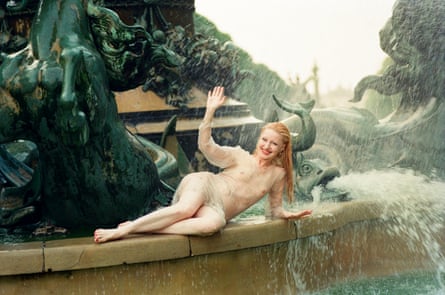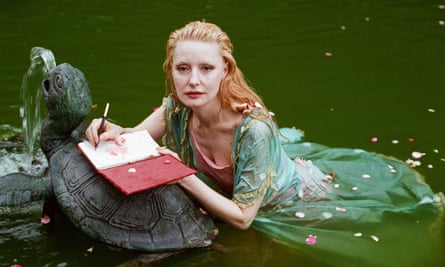Shere Hite was a legend of her time who landed in my small ex-council flat when I was in my 20s. She was two decades older and seemed to me to be an extraordinary, exotic creature transmuted from celluloid into strange reality in my home. To those over 50, Hite – a pivotal figure in the second wave feminist movement – was a much-photographed writer and sexologist: a mix between Germaine Greer and a movie star. To those younger, the name draws a blank. Hence the title of Nicole Newnham’s superb new documentary, The Disappearance of Shere Hite.
I had known about this feminist author from my mother’s bookshelf when I was a child, read about her in Cosmopolitan as a teenager and was quite fascinated by the idea of her by the time I was 25 and went to interview her.
Born in Missouri in 1942, she published The Hite Report in 1976, which has sold more than 50m copies and is by some estimates the 30th bestselling book of all time. It was a landmark that brought her wealth and fame and upended the dialogue on female sexuality, most notably by proving that most women orgasmed through clitoral stimulation rather than penetration. Her later surprising findings about male insecurity in The Hite Report on Male Sexuality (1981), and female marital dissatisfaction in Women & Love: A Cultural Revolution in Progress (1987), were anathema to the increasing conservatism of the US in the 1980s. The backlash against her and her work was so extreme that eventually she renounced her American citizenship.
So there she was, in London in 1989, for the appointed interview, ridiculously beautiful at 46 in a pale, almost unearthly way. She was glamorous, and the 1940s Hollywood style that she had made her own cast her as different from others in the feminist movement, who tended to adopt a more practical aesthetic. She greeted me by pouncing on my burgundy velvet jacket: she loved it, so she sent her poor publicist off to the shops with her credit card to find one – but none were to be found.

We talked about feminism, life, publishing, politics, relationships. I was drenched in her charm, floating on her weird, hypnotic voice as she wove words such as “clitoris” and “masturbation” through her sentences. A bouquet arrived from a newspaper. She decided she wanted to give it to me. I left our meeting floating beneath flowers, my fascination thoroughly reinforced. On my way back to the office, I went into the shop where I had bought my jacket. A single one was left. In the sale. It had to be.
A few days later, Shere’s voice drifted from my clunky tape answering machine, thanking me for the jacket I’d sent and giving me her New York number. Eighteen months later, she was in my flat. Having fled the US, she had been commuting between Paris, the Kensington Hilton and a mattress on the floor of a squat in north London: the ways of her formerly wealthy life clashing with the financial reality of her present. She perpetually swung between spending and thrift.

By the time I got to know her in 1990, she was in trouble. She had been the victim of vicious media attacks, doorstepping, public humiliation and death threats, all of which contributed to the loss of her American publishers and of her ability to make a living. Her findings on sex – now widely accepted – caused outrage, and her appearance was used by critics to detract from the seriousness of her work at a time when there were rigid expectations of what a feminist firebrand should look like. She could also be difficult, it has to be said. Most notoriously, she apparently attacked a limo driver who had called her “dear”.
She became a European citizen before quietly separating from her German husband, with whom she was barely in contact in the years I knew her. We had begun an on-off relationship in Paris, and between 1991 and 1997, she lived largely between France and my home, where she researched and wrote ceaselessly. The royalties from those hit books still came in, but she needed a market for new work and dedicated herself to rebuilding her career with phenomenal focus.
Shere had never known her father and had been abandoned twice by her mother. Then the grandparents who raised her divorced and she was sent to be raised by an aunt. Clearly this was not a stable foundation for life as an activist whose theories caused such fury. In London, after she had begun to lose the wealth and success she had created, she retreated, to hide, recover and restock.
She would write for much of the night, sometimes in pyjamas and curlers, as she worked on new theories. She slept in the day, waking in time for us to go out to dinner. It was her only real leisure activity apart from bouts of high-speed shopping at Harvey Nichols – her personal style was vital to her identity. Occasionally, we crossed in the morning: as I was getting up, she was going to bed. Her somewhat vampiric pallor along with her almost disconcerting beauty could make her seem illusory. Other times, she failed to emerge from behind her piles of papers even into daylight.

I was writing my first novel while supporting myself as a features writer, while Shere, who described herself as a “cultural historian”, was trying to figure out the state of the world, untangle it and capture it in accessible form. She was eternally curious, asking me questions about sex, politics and younger women’s emotional lives. I could offer her a different viewpoint that was useful – but could be discomfiting if it wandered too far from her own theories. She didn’t look like any of my friends. Her skin was whiter than anyone’s I knew, contrasting with scarlet lipstick. Her slenderness and elegance belonged more on screen than real life. She exercised daily, always indoors, once disappearing into a cupboard in a bookshop to complete her stretches before giving a speech.

Shere had an extraordinary effect on people – possessing a strange, delicate charisma that hooked them. “Our team did all fall a bit in love with her, I think,” says Newnham, about making her documentary. At the parties I had in my flat, I could see the gazes, the entrancement, the curiosity. “I thought waists like that only existed in the 18th century,” said one guest, goggling at her in her Norma Kamali jacket. Business cards were pushed into her hands. Dates suggested. Projects proposed. People – including me – always felt the need to help her; taxi drivers would leap out of their car to carry her bags. She took it all in her stride: the cards proliferated on her desk, ignored or Sellotaped to her notes as she worked on. Seemingly never maternal, in some ways she needed mothering herself. Perhaps others sensed this.
The weirdness of having what a friend called “that international diva” ensconced in my flat cannot be underestimated. “What? Shere Hite’s in there?” people would exclaim, glancing up at the unprepossessing block.
People wanted a piece of the feminist femme fatale, yet once my closest friends had got over the novelty – much as I adored her – I needed a break from the intensity an existence with Shere entailed. We would intermittently hide, going for drinks at the nearby Russell Hotel instead of in my flat because we wanted to distance ourselves from what I can only describe as the Shere Show, and giggle and talk twentysomething nonsense without her scrutinising us or correcting us if she detected sexism, fervent young feminists though we all were.
In retrospect, I see that I was out of my depth in trying to steer through life with Shere, exciting though it was. My much-loved father had recently died young; I was in a state of bereavement, working hard, and here was this woman with a whole career established and a marriage behind her, although her otherworldly presence was also a distraction from the grief.
A novelist friend later said about that period: “I thought you were living a kind of dream life.” I gasped at the idea. My youthful neuroses, bereavement, crying fits and self-castigation flourished alongside vanity and daring. I see now that spending so much time with that dazzling trailblazer, with her decades of experience, her sophistication and celebrity lifestyle – aspects of which remained as she flew to Hamburg for a haircut and bought piles of unaffordable designer clothes – was hard to negotiate as a young woman trying to make her own way.

But during this period, she was oddly isolated, and didn’t seem to have kept many friends from her New York years, when she had her Fifth Avenue apartment and went to celebrity parties. I’d come back home amused to find long messages from Ruby Wax for her on my answerphone, yet she was largely a recluse. She was as fragile as she was tough. As guarded as she was flamboyant.
She would stay a month, disappear to Paris and Rome, engage in mysterious activities, the Roman connection vague, then come back and stay for more months. She took over my basement storage locker with her clothes and papers, just as she did in other cities. She took offence freely. It was easy to say the wrong thing and wind up her sensitivity, a kind of narcissistic armour protecting her from the darkness of her earlier years. As her ex-boyfriend, the writer Martin Sage, said: “It was like entering a different universe and not understanding the rules.” She was well known for screaming and losing her temper, getting us chucked out of taxis for it. I was once with her in La Coupole in Paris when she turned against a waiter and started throwing sugar lumps at him while I sat there open-mouthed.
It was also enormous fun. As an impassioned young feminist, full of the revolution, I loved listening to this fighter for the cause, refining my perceptions of patriarchy. We both loved clothes and she took me to hidden secondhand shops in Islington before “vintage” was a concept and was always good for a styling session. We watched the early Hollywood films she loved, the sillier and more music-filled the better, listened to political debates and discussed at length her horror at the rise of the religious right in the US.

She rarely cooked or cleaned the flat, and wrapped up steaks from restaurants to take home in her handbag. I would return home to find my fax machine emptied of paper, piles of work on every surface, some cheap wacky present from her on the table or the most beautiful long-stemmed roses I had ever seen. When I had my first novel accepted for publication, she bought me a velvet heart-shaped Lacroix necklace that now looks as though it came straight from Absolutely Fabulous, yet was much treasured. She once admitted she had thrown her sheets down the rubbish chute in Paris rather than wash them, finding it quicker to buy more. I found all this hilarious – I was much more stimulated by the wildness and naughtiness of others than I was by doing this kind of thing myself.
This was a sentimental education, a rich and frustrating and eye-opening period, and despite all the dramas and demands, I’m glad she was there. This woman was truly ahead of her time. Regardless of her strict religious 1940s upbringing, she somehow thought in a clear-sighted and entirely liberal way, called herself bisexual before it was acceptable and was rarely shocked by anything. A revolution was going on inside her head. She was genuinely passionate about her message.
Time moved on, we formed different lives, but we kept up a friendship, and Shere eventually moved to London full-time. I last saw her when she became ill, in my house with my family and her partner, along with the photographer Iris Brosch, whose portraits had given her so much pleasure. When she died in 2020, the obituaries were widespread to the extent that various film-makers began to wonder why they had never heard of such a significant figure and started to pitch documentaries. Newnham, who, like me, had seen her mother’s copy of The Hite Report, succeeded in the task.
At a time when the fight must be continued, when women’s history is routinely erased, I’m so very happy that Shere is being celebrated as she should be. She deserves to be acknowledged by a new generation. I think of her when I wear a particular velvet jacket she gave me, and recently realised that the story of velvet jackets came full circle. She was a revolutionary; an iconoclast of great tenacity and courage who completely changed the conversation about women and sex. She enhanced all our lives.







